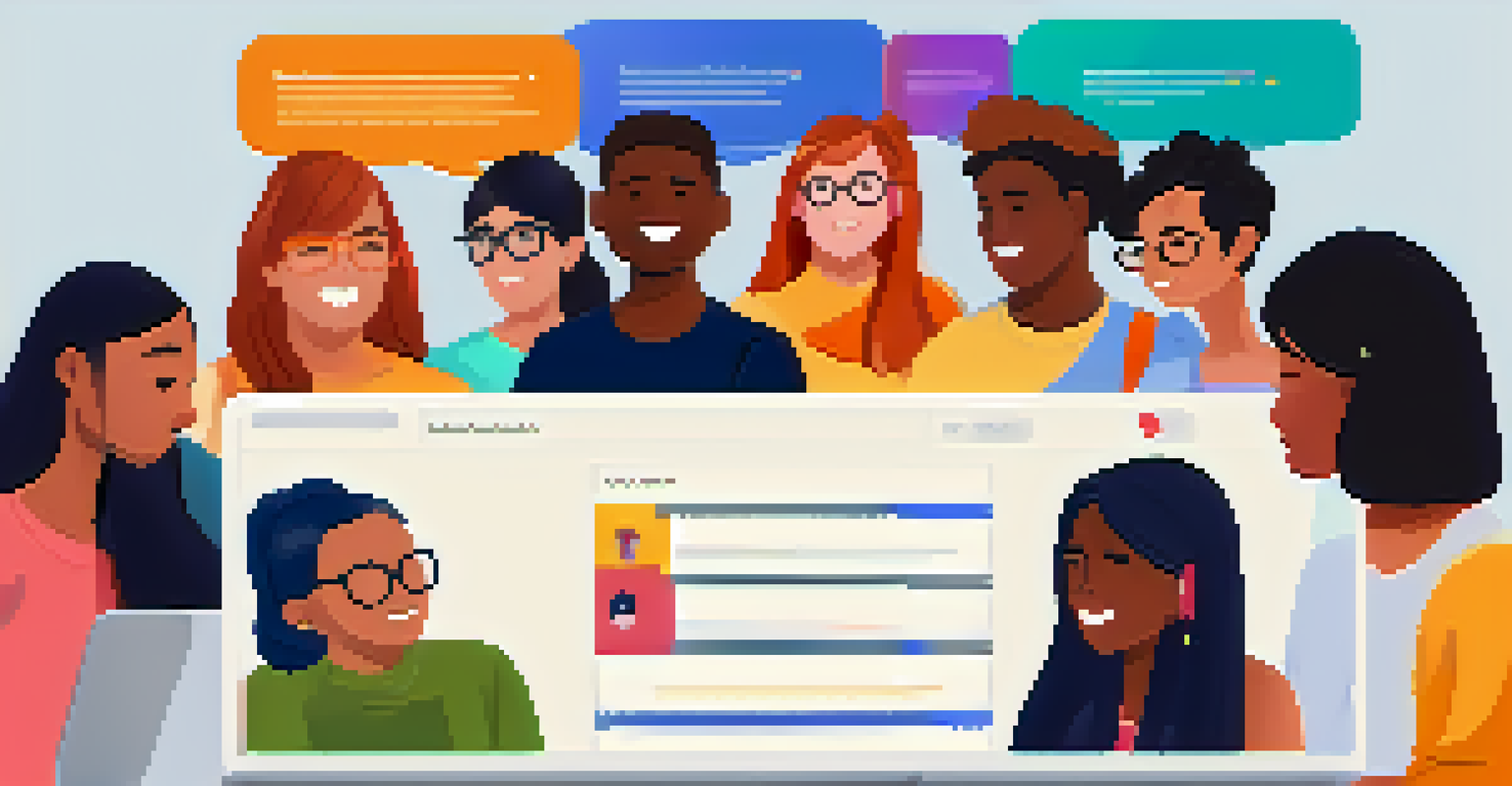The Importance of Building Trust in Digital Learning Environments

Understanding Trust in Digital Learning Contexts
Trust in digital learning environments refers to the confidence students have in the platform, instructors, and content. It’s vital because, without trust, learners are less likely to engage fully with the material. Think of it like a relationship; just as you wouldn’t invest in a friendship with someone you don’t trust, students won’t dedicate their time or effort to a learning experience that feels suspect.
Trust is the foundation of all relationships, including those between teachers and students.
Trust can be built through transparency, reliability, and consistent communication. When instructors are open about their teaching methods and responsive to student needs, it fosters a secure learning atmosphere. This environment encourages students to ask questions, share ideas, and participate actively, knowing their contributions are valued.
Moreover, establishing trust can lead to improved academic performance and satisfaction. When learners feel confident in the integrity of their digital environment, they are more likely to take risks and challenge themselves, leading to deeper learning experiences. In essence, trust is the foundation upon which effective digital education is built.
The Role of Instructors in Building Trust
Instructors play a pivotal role in cultivating trust within digital learning settings. Their approachability, responsiveness, and expertise can significantly influence students’ perceptions of the learning environment. For instance, when an instructor promptly answers questions and provides constructive feedback, it shows that they value student input, which in turn builds trust.

Additionally, instructors can foster a sense of community through regular interaction and encouragement. Using discussion boards, video calls, or even informal check-ins can make students feel more connected and supported. This sense of belonging can strengthen trust, making students more willing to engage and collaborate with their peers.
Trust is Essential in Learning
Trust in digital learning environments fosters student engagement and leads to better academic performance.
Furthermore, instructors who share their own learning journeys, including challenges and successes, can humanize the learning experience. When students see their instructors as relatable individuals, it breaks down barriers and enhances trust, ultimately leading to a more enriching educational experience.
Creating a Safe and Inclusive Learning Environment
A safe and inclusive learning environment is crucial for building trust among students. When learners feel respected and valued, they are more likely to express their thoughts and ideas freely. This atmosphere can be achieved by setting clear expectations for behavior and actively promoting diversity and inclusion within the curriculum.
In a digital world, trust is the currency that enables collaboration and engagement.
For example, incorporating diverse perspectives in course materials not only enriches the learning experience but also makes students feel recognized. When learners see themselves represented, it fosters a sense of belonging and trust in the educational process. They know that their unique experiences and viewpoints are acknowledged and valued.
Moreover, creating a safe space for discussions around sensitive topics encourages open dialogue. When students feel they can share their opinions without fear of judgment, it strengthens trust between peers and instructors alike. This openness leads to deeper learning, as students feel empowered to explore complex ideas and collaborate with one another.
Leveraging Technology to Enhance Trust
Technology plays an essential role in fostering trust in digital learning environments. Tools such as Learning Management Systems (LMS) can provide transparency by allowing students to track their progress and access resources easily. When learners have clear visibility into their learning journey, it enhances their confidence and trust in the system.
Additionally, features that promote interaction, like forums and chat functions, can help students feel more connected to their peers and instructors. These tools facilitate communication, making it easier for learners to seek help or share insights. When technology supports active engagement, it reinforces the trust students have in their educational experience.
Instructors Build Trust Through Interaction
Instructors can cultivate trust by being approachable, responsive, and sharing their own learning experiences.
Furthermore, utilizing technology for assessments, like peer reviews or self-assessments, can empower students. When learners are involved in evaluating their work and that of others, it fosters a culture of accountability and trust. They become stakeholders in their education, leading to a more invested and collaborative learning environment.
The Impact of Trust on Student Engagement
Trust significantly influences student engagement in digital learning. When students trust their instructors and the learning platform, they are more likely to participate actively. This engagement is crucial because it often correlates with better learning outcomes and retention of information.
For instance, trust encourages students to contribute to discussions, share ideas, and collaborate with peers. In an environment where they feel safe and respected, students are more likely to take intellectual risks, which can lead to innovative thinking and deeper understanding of the material. This active participation is key to a vibrant learning community.
Moreover, a trusting relationship with instructors can lead to increased motivation. Students who feel supported and understood are more likely to persevere through challenges and remain committed to their studies. Trust transforms the learning experience from a transactional process into a meaningful journey of growth and discovery.
Overcoming Barriers to Trust in Digital Learning
While trust is fundamental to digital learning, there are barriers that can hinder its development. One common challenge is the anonymity of online interactions, which can lead to misunderstandings and a lack of accountability. When students don’t know their peers or instructors personally, it can be difficult to foster trust.
Another barrier is the potential for technology-related issues, such as glitches or unclear instructions. If students encounter technical problems that disrupt their learning experience, it can erode their trust in the platform and its effectiveness. Addressing these issues proactively is essential to maintaining a positive learning environment.
Creating Inclusive Environments Matters
A safe and inclusive learning space encourages open dialogue, which strengthens trust among students and instructors.
To overcome these barriers, it’s important to establish clear communication and provide support. Regular check-ins, user-friendly resources, and technical assistance can help bridge gaps and build trust. By being proactive and responsive, educators can create a more trustworthy digital learning experience that encourages student engagement and success.
The Long-term Benefits of Building Trust
Building trust in digital learning environments offers long-term benefits for both students and educators. For students, a strong sense of trust can lead to greater academic success, increased motivation, and a more positive attitude toward learning. This supportive environment encourages lifelong learning and curiosity, traits that are invaluable in today’s fast-paced world.
For educators, fostering trust can result in a more cohesive and collaborative learning community. When students feel comfortable sharing their thoughts and feedback, instructors can continuously improve their teaching methods and content. This open dialogue can enhance the overall quality of education, benefiting everyone involved.

Moreover, institutions that prioritize trust in their digital learning environments are likely to see improved retention rates and student satisfaction. When learners feel valued and supported, they are more likely to remain engaged with their studies and complete their programs. Ultimately, trust is not just a short-term goal; it’s a vital component of a thriving educational ecosystem.